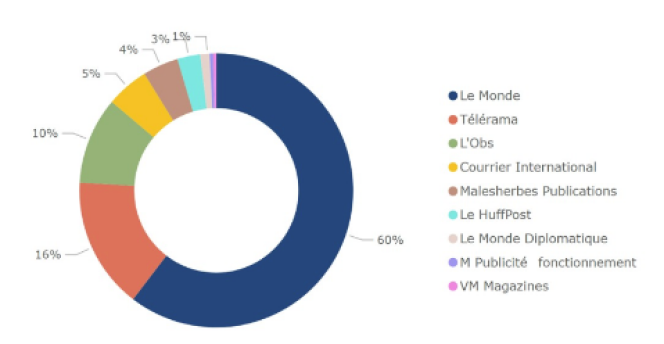

Le Monde made a commitment, upon adopting its Climate & Environment Charter in April 2023, to make its carbon footprint data available to readers and to establish targets for reducing its footprint. It has now achieved this, with the publication of an assessment of Le Monde Group and L'Obs's greenhouse gas emissions for 2022, produced by climate consultancy EcoAct. This assessment will be available for viewing on the website of the French Environment and Energy Management Agency (ADEME).
When measured against the previous one, which covered the 2019 financial year, the analysis for 2022 has revealed unmistakable progress. When the same parameters are applied, the press group's carbon footprint fell from 41,374 tonnes of CO2 equivalent in 2019 to 29,461 tonnes in 2022, a reduction of 29% in emissions. In the meantime, Le Monde Group and L'Obs continued forging ahead with their digital makeover, and the teams of both newspapers also moved, in 2020, into a new building that has been rated as "excellent" according to the High Environmental Quality (HEQ) standard.

Le Monde Group includes Courrier International, Le HuffPost, Le Monde, Le Monde Diplomatique, Télérama and La Vie, as well as an advertising agency (M Publicité) and a cross-functional subsidiary (VM Magazines). Emissions from L'Obs, a "cousin" publication governed by the same shareholders as Le Monde that shares the latter's headquarters, were included in determining the carbon footprint.
Calculating this footprint has become (somewhat) complicated by the process of taking into account new variables. Foremost among these is the role of the manufacture of digital equipment and of its use by readers, the inclusion of which provides a more comprehensive and complete understanding of emissions linked to the company's operations. As can be seen from the chart below, its activities are far from having a neutral impact. Once these expanded parameters are applied, the carbon footprint of Le Monde Group and L'Obs is found to have reached 67,420 tonnes of CO2 equivalent in 2022, an amount roughly equivalent to the annual emissions of 6,700 French people. Le Monde by itself accounts for 40,722 tonnes, or 60%, of this total.

These carbon footprint data enable us to answer a question that has been asked by both Le Monde Group teams and readers of our publications: Which emits the most greenhouse gases, paper or digital? Taking into account Le Monde alone (daily print edition, website and applications), the result is clear: Digital activity accounts for 62% of its carbon footprint (representing 80% of its paid circulation) and paper activity 28% (20% of paid circulation), with the remainder (10%) stemming from Le Monde's operations.
The verdict is that in absolute terms, digital is more energy intensive. But when we analyze the carbon footprint of each distribution method in the context of its usage by Le Monde's readership, we find that a printed copy has more impact with regard to greenhouse gas emissions than does a digital reading.
This new report also measures the carbon footprint of the devices that our readers use to read Le Monde. The calculation has taken into consideration the entire lifecycle of these computers, tablets and smartphones, but has done so according to the time spent using them to read Le Monde as opposed to all the other purposes for which their owners employ them.
The result is, to say the least, staggering: Thirty-eight percent of Le Monde Group's total carbon footprint results from this mode of reading its publications. Please note that this does not mean we are shifting the burden of responsibility onto our readers, but rather that we have developed a comprehensive vision of the impact of our activities on greenhouse gas emissions. The other major element in Le Monde Group's digital activities is the transfer of data to users (10% of the overall carbon footprint), while storage in data centers represents only around 2% of the total.
In the area of print production, the main emissions factor has remained paper purchasing, which accounts for 24% of Le Monde Group's carbon footprint. Also, it is important to bear in mind that unlike its daily newspaper circulation, the group's weeklies are still predominantly read on printed paper. The distribution of printed newspapers accounts for around 5% of the carbon footprint. As for travel by group employees (mostly for reporting and commuting), it accounts for less than 4% of the overall footprint.

Le Monde Group has already set a course for reducing the size of its carbon footprint by 2025. Among the avenues being pursued by the digital side of the business are a reduction in the role of data and the migration of information to data centers powered 100% by renewable energy. For its paper operations, it plans to switch to a fleet of clean vehicles for the vendors responsible for newspaper delivery and to reduce the number of unsold copies.
At an operational level, the group has undertaken actions to extend the lifespan of its electronic equipment. Such measures are also ones that readers of Le Monde Group publications can themselves adopt in order to help shrink their carbon footprint. The next evaluation of Le Monde Group's emissions is scheduled for 2024 and will be published in 2025.
Translation of an original article published in French on lemonde.fr; the publisher may only be liable for the French version.
